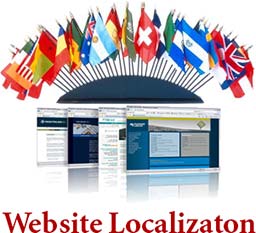Localization Kit Essentials for a Website Translation Project
As continuation of my earlier blog on document translation localization kit basics, I am sharing localization kit essentials for a website translation project. This will help identify what you should provide to a translation company in order to obtain an accurate quotation on project cost. Providing your translation agency with accurate and complete project assets at the time of a quote request will enable your translation vendor to produce a quotation promptly and accurately.
A website localization kit is comprised of the same source files, metadata and project specifications that your translation services agency will require in order to execute the actual website translation and localization. Quite simply this consists of your source files and the specific information required to understand the scope of your project.

Web crawl is insufficient to determine website translation project scope
At Globalization Partners International® we frequently get requests for website localization quotes from prospective clients who simply provide a URL link to their website home page. Unfortunately, a “web crawl” rarely provides an accurate review of a website or sufficient information to estimate website translation project scope and costs.
- The word count analysis may be incorrect and the project scope may be misunderstood or inaccurate as a result of this process.
- The project scope may not include webpage translation or localization for certain sections of the website, which would be covered by the web crawl.
- The source website may also include multimedia files and downloadable documents, which a web crawler cannot analyze.
- Web crawling cannot access key content that is pulled from a database on a user-demand basis.
Minimum ingredients for website translation project localization kit
Source files
Source files include website content along with any source graphics that will be within project scope. Source application files and source multimedia files that may be in scope should also be included with source files submitted as part of your website localization kit.
Your source content may be an export from your content management system (CMS.) If the CMS export is performed properly and all of your content resides within the CMS, then these may be the only files that your translation company will need. However, this is often not the case, even when a CMS is being used. Frequently, content that is within the project scope may reside outside of the CMS and will need to be provided to your translation vendor separately.
If you have document files on your website which are within project scope, you should provide these source documents as part of your website localization kit. See our previous blog, “Why a Localization Kit is Essential for Documentation Translation.”
Glossary and style guides
Many times, clients do not have glossaries or style guides available. If not, your translation vendor can create these as part of your project. A glossary is a very important foundation tool for the translation team to use on your website translation project. Having key terminology defined and agreed upon early on will save time within the review process for your project. It will also aid in all future website projects as well.
Translation memory
If you have worked with a translation vendor before then you should be able to request your translation memory (TM) from them. This asset will reduce your translation costs, save time and maintain consistency in your translation.
Translation memory is not a previously translated source file and it is not machine translation. TM is actually a database file that matches the source language segments (i.e. sentences, phrases, etc.) with the matching segment for each language from past translation. For further detail, review our previous blog, “What is a translation memory (TM)?”
Translation memory (TM) technology allows translation teams to store and reuse both source and target language content for any translation project. Your translation vendor’s linguistic teams utilize translation memory tools in order to create and maintain multilingual glossaries and translation memories for their clients.
Website translation project scope
You will also need to provide your translation vendor with basic project scope details such as:
- Target languages and locales that you require for translation should be identified. In particular, please clarify the locale for such languages as Chinese, French, Portuguese and Spanish.
- Timeframe: be as specific as possible defining the timeframe for your project, including key milestones such as review and testing.
- Provide your translation company with your website’s URLs and any password or login instructions.
- Are global SEO services required? If so, be sure to provide your keywords, ads and additional metadata, if this information is not available in your CMS export. You may wish to review our previous blog, “Why are Multilingual Keywords important for your international websites?“
- If possible provide a summary of your website’s site architecture and any tools used to develop your site. An experienced translation vendor will review your site structure and determine if there may be any internationalization issues to address. For example, we find that almost all Content Management Systems in use today say they support all languages, but some may not support multiple languages. A translation company like GPI will be able to verify such concerns upfront.
Providing a subset website localization kit
While some clients provide a full localization kit, many clients provide a subset. In some cases, this can be acceptable. The most important items to provide as part of your website localization kit are:
- Source files
- Any existing translation memory which is available
- Basic details of the project scope
Beyond that, your translation vendor can discuss any other items with you while you confirm your project requirements and expectations.
GPI’s Website localization kit summary
GPI has created a comprehensive Website Globalization Guide, freely available for download. This Guide gives a highly detailed workflow typical of website translation and website globalization projects. The last page of this guide included the following summary of a website localization kit:
You will be asked to provide your translation company with a complete set of source files, also known as a “Localization Kit.”
Website localization kit should include:
- Your site(s) URL
- Any passwords or login instructions
- Summary of site architecture
- Summary of any technologies and/or development toolsets used to develop your site
- All files that make up your site in their original folder/file structure
- All original graphics used in your site (artwork, background, navigation buttons)
- All application source files (Word, FrameMaker, Quark, etc.) for any documentation available via your site
- All application source files (Flash, Director, Authorware, etc.) for any multimedia available via your site
- A list (if available) of all files that need to be translated
These files are analyzed for:
- Number of words
- Source and target languages
- Subject matter
- Desktop publishing requirements
- Client workflow requirements
A comprehensive quotation packet is generated, including all tasks, costs and timelines required to complete the project. Clients are given the opportunity to review and approve every quote.
